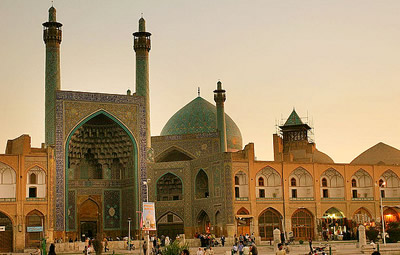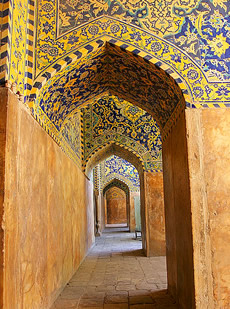World History
In 1592 Shah Abbas I made Isfahan the capital of the Safavid Empire. In an earlier era, Isfahan had been the capital of the Seljuk Empire, but under Shah Abbas the city became a major economic and cultural center or as the Persian saying went, “Isfahan is half the world.â€
The Masjid-i Jami, or Friday Mosque (1088), an earlier Seljuk building, dominates one section of the city. This mosque is known for its brick domed chambers and stucco mihrab (prayer niche). Under Shah Abbas, a huge open square, the Maydan-i Shah, with a polo field the favorite amusement of the Safavid court, became the centerpiece of the city. The square was surrounded by Safavid buildings.
The Masjid-i Shaykh Lutfallah (1602) stands on one side; a vast covered bazaar anchors another, and the monumental Masjid-i Shah (1612–13) dominates a third side. An elaborately decorated blue tiled dome with Qu’ranic inscriptions in finely wrought calligraphy covers the mosque, which is entered through a courtyard and towering iwans, or arched entryways.
The Ali Qapu, a vast royal palace complex, is the main building on the fourth side of the square. The palace’s second-story porch, covered by a wooden roof supported by slender columns, overlooks the square. From this porch, the shah and his court could watch polo games and other state ceremonies.
As a commercial center, Isfahan attracted numerous traders and artisans, many of whom built lavish homes with gardens that were much esteemed in Persian society. The bazaar sold everything from common everyday products to luxury goods including silk brocades, jewelry, carpets, and painted miniatures. As in the Ottoman Empire, flowers and bird motifs were favorite designs among the Safavids.
The Safavids became known for Persian carpets with floral patterns and center medallions as opposed to the geometric designs favored by tribal artisans. Safavid artists also excelled in the painting of miniatures and illustrated manuscripts, many of which included figural representations that were rare in Arab or Ottoman works.
- Nadir Shah - Persian Conqueror
Nadir Shah (Nader Shah), often called the “Napoleon of Iran,†was the last of the Central Asian conquerors who made the region quake under the hoofbeats of his army. Like Genghis Khan, Babur the Tiger, and Timurlane before him, Nadir came...
- Ottoman-safavid Wars
Ottoman-Safavid Wars The protracted conflict between the Ottomans and the Safavids was based on territorial and religious differences. Both great empires sought to control vast territories in present-day Iraq, along the Caspian and their mutual borders....
- Safavid Empire
Safavid Empire The Safavid Empire was established as the Mongol il-Khan government declined and the Safavids were victorious over the numerous Turkish tribes who had established independent fiefdoms in Persia (present-day northern Iran) during the 13th...
- Abdul-menan Sinan - Ottoman Architect
Abdul-Menan SinanSinan was born in Kayseri in central Anatolia to a Greek Orthodox family. When he was in his early 20s, older than was customary, he was recruited in the devshirme levy to be educated in Istanbul. He was selected for the elite Janissaries...
- History Of Iran
History of Iran. This is an essay on the history of Iran which was known as Persia in ancient times. From the site: The ancient nation of Iran, historically known to the West as Persia and once a major empire in its own right, has been overrun frequently...
World History
Isfahan (Persia)
 |
| Isfahan (Persia) |
In 1592 Shah Abbas I made Isfahan the capital of the Safavid Empire. In an earlier era, Isfahan had been the capital of the Seljuk Empire, but under Shah Abbas the city became a major economic and cultural center or as the Persian saying went, “Isfahan is half the world.â€
The Masjid-i Jami, or Friday Mosque (1088), an earlier Seljuk building, dominates one section of the city. This mosque is known for its brick domed chambers and stucco mihrab (prayer niche). Under Shah Abbas, a huge open square, the Maydan-i Shah, with a polo field the favorite amusement of the Safavid court, became the centerpiece of the city. The square was surrounded by Safavid buildings.
  |   |
The Masjid-i Shaykh Lutfallah (1602) stands on one side; a vast covered bazaar anchors another, and the monumental Masjid-i Shah (1612–13) dominates a third side. An elaborately decorated blue tiled dome with Qu’ranic inscriptions in finely wrought calligraphy covers the mosque, which is entered through a courtyard and towering iwans, or arched entryways.
The Ali Qapu, a vast royal palace complex, is the main building on the fourth side of the square. The palace’s second-story porch, covered by a wooden roof supported by slender columns, overlooks the square. From this porch, the shah and his court could watch polo games and other state ceremonies.
 |
| Persian floral patterns |
The Safavids became known for Persian carpets with floral patterns and center medallions as opposed to the geometric designs favored by tribal artisans. Safavid artists also excelled in the painting of miniatures and illustrated manuscripts, many of which included figural representations that were rare in Arab or Ottoman works.
- Nadir Shah - Persian Conqueror
Nadir Shah (Nader Shah), often called the “Napoleon of Iran,†was the last of the Central Asian conquerors who made the region quake under the hoofbeats of his army. Like Genghis Khan, Babur the Tiger, and Timurlane before him, Nadir came...
- Ottoman-safavid Wars
Ottoman-Safavid Wars The protracted conflict between the Ottomans and the Safavids was based on territorial and religious differences. Both great empires sought to control vast territories in present-day Iraq, along the Caspian and their mutual borders....
- Safavid Empire
Safavid Empire The Safavid Empire was established as the Mongol il-Khan government declined and the Safavids were victorious over the numerous Turkish tribes who had established independent fiefdoms in Persia (present-day northern Iran) during the 13th...
- Abdul-menan Sinan - Ottoman Architect
Abdul-Menan SinanSinan was born in Kayseri in central Anatolia to a Greek Orthodox family. When he was in his early 20s, older than was customary, he was recruited in the devshirme levy to be educated in Istanbul. He was selected for the elite Janissaries...
- History Of Iran
History of Iran. This is an essay on the history of Iran which was known as Persia in ancient times. From the site: The ancient nation of Iran, historically known to the West as Persia and once a major empire in its own right, has been overrun frequently...
